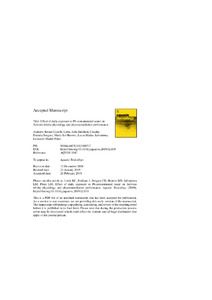Por favor, use este identificador para citar o enlazar este ítem:
https://repositorio.uca.edu.ar/handle/123456789/8772| Título: | Effect of daily exposure to PB-contaminated water of Salvinia biloba physiology and phytoremediation performance | Autor: | Castillo Loria, Kristel Emiliani, Julia Bergara, Claudia Daniela Herrero, María Sol Salvatierra, Lucas Matías Pérez, Leonardo Martín |
Palabras clave: | CONTAMINACION DEL AGUA; SALVINIA BILOBA RADDI; PLOMO; FITORREMEDIACION; METALES PESADOS | Fecha de publicación: | 2019 | Editorial: | Elsevier | Cita: | Castillo Loría K, Emiliani J, Bergara CD, Herrero MS, Salvatierra LM, Pérez LM. Effect of daily exposure to Pb-contaminated water on Salvinia biloba physiology and phytoremediation performance [en línea]. Aquatic Toxicology. 2019;210:158–166. doi:10.1016/j.aquatox.2019.02.019 Disponible en: https://repositorio.uca.edu.ar/handle/123456789/8772 | Resumen: | Abstract: Lead (Pb) removal from water column was evaluated in batch experiments using naturally occurring Salvinia biloba Raddi (S. biloba) specimens collected from Middle Paraná River and exposed every 24 h to a fresh discharge of water contaminated with 2.65±0.07, 12.62±0.02 or 30.57±0.01 mg L-1 Pb, during 10 consecutive days. S. biloba demonstrated a great ability for metal concentration-dependent Pb removal under these stressful conditions. Additionally, Pb toxicity in plants was assessed by the quantification of physiological parameters in root-like modified fronds (named “roots”), and its aerial leaf-like fronds (named “leaves”) of submerged S. biloba. Photosynthetic (carotenoids, chlorophyll a, b, and total) and antioxidant pigments (anthocyanins and flavonoids), soluble carbohydrate content, and membrane stability index of both roots and leaves were affected as the metal concentration increased. In general, root deterioration was more pronounced than that in leaves, suggesting a greater implication of the former organs in Pb removal by S. biloba. All of these deleterious effects were well correlated with qualitative changes observed at plant phenotype during the assay. In conclusion, S. biloba may be considered as a water fern useful in phytoremediation strategies towards management of residual water bodies contaminated with Pb. In addition, these macrophytes could also be valuable for water biomonitoring contributing to improve risk assessments related to metal presence in wastewaters. | URI: | https://repositorio.uca.edu.ar/handle/123456789/8772 | ISSN: | 0166-445X (impreso) 1879-1514 (online) |
Disciplina: | INGENIERIA AMBIENTAL | DOI: | 10.1016/j.aquatox.2019.02.019 | Derechos: | Acceso abierto. 2 años de embargo | Fuente: | Aquatic Toxicology, 2019(210),158-166 |
| Aparece en las colecciones: | Artículos |
Ficheros en este ítem:
| Fichero | Descripción | Tamaño | Formato | |
|---|---|---|---|---|
| effect-daily-exposure-contaminated-water.pdf | 896,96 kB | Adobe PDF |  Visualizar/Abrir | |
| effect-daily-exposure-contaminated-water.jpg | 3,69 kB | JPEG |  Visualizar/Abrir |
Visualizaciones de página(s)
173
comprobado en 30-abr-2024
Descarga(s)
215
comprobado en 30-abr-2024
Google ScholarTM
Ver en Google Scholar
Altmetric
Altmetric
Este ítem está sujeto a una Licencia Creative Commons

